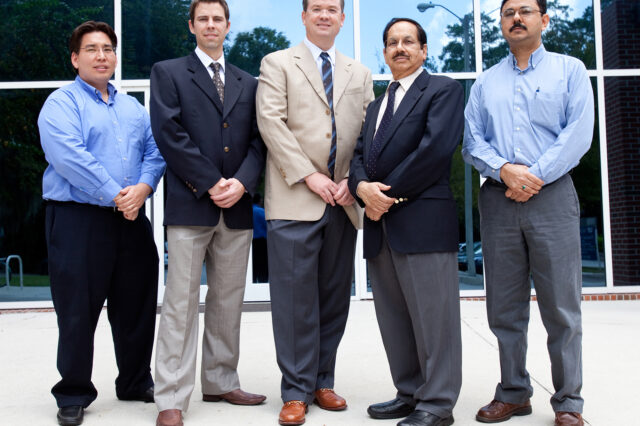UF surgeons, particle engineers receive grants to research breast cancer treatments

A team of UF College of Medicine and College of Engineering researchers has received three Department of Defense Breast Cancer Concept Awards and a grant from the Margaret Q. Landenberger Research Foundation to support its work to develop new methods of treatment delivery for breast cancer patients. The team includes, from left, Scott Brown, Ph.D., research assistant scientist, Particle Engineering Research Center; Luke Gutwein, M.D., surgical resident researcher, College of Medicine; Stephen Grobmyer, M.D., associate professor of surgery, COM; Brij M. Moudgil, Ph.D., a professor in the College of Engineering and director of the PERC; Parvesh Sharma, Ph.D., a postdoctoral associate, PERC. Not pictured is Vijah Krishna, Ph.D., a postdoctoral associate with PERC. (Photo by Jesse S. Jones/University of Florida)
University of Florida surgeon Stephen Grobmyer, M.D., and his collaborators in the department of surgery and College of Engineering have been awarded three U.S. Department of Defense Breast Cancer Concept Awards and a research foundation grant totaling nearly $600,000 to develop new ways to deliver treatment to breast cancer patients.
The money will fund research on three potential delivery methods that may one day allow doctors to target tumors in hard-to-reach places without damaging healthy cells nearby. All three projects rely on nanotechnology.
Working with Grobmyer, an associate professor of surgery at the University of Florida College of Medicine, are surgical resident researcher Luke Gutwein, M.D., and College of Engineering researchers Brij M. Moudgil, Ph.D., a professor and director of the Particle Engineering Research Center; Scott Brown, Ph.D., a research assistant scientist at the center; Vijay Krishna, Ph.D.; and Parvesh Sharma, Ph.D.; both postdoctoral associates at the center.
The aim of the DOD Breast Cancer Concept Award program is “to probe new promising avenues of research that are a little high risk, high reward,” said Grobmyer, who also is a member of the UF Shands Cancer Center.
The Department of Defense funded only about 5 percent of the 1,238 Concept Award applications it received. The defense department grants, each worth $111,376 for one year, will begin in October. In addition, the Philadelphia-based Margaret Q. Landenberger Research Foundation has awarded Grobmyer $250,000 for two years.
The grants will allow UF’s researchers to conduct preliminary studies and collect data needed to secure funding for further research on potential delivery methods. The research could lead to less invasive treatments that are more effective and more comfortable for patients than current procedures. They also could enable new theranostic strategies, which link therapeutic and diagnostic techniques, for breast cancer.
“Right now what we do is we image cancer, and then we design a treatment for it,” explained Grobmyer. “With theranostics, which nanotechnology is enabling, you can combine the diagnosis and treatment all into one modality.”
One delivery method the team will investigate would require attaching treatment or imaging nanoparticles to glucose molecules and injecting the combined materials into the patient. Because cancer cells consume much more glucose than healthy ones do, tumors will take in many of the glucose cells and accompanying nanoparticles. Grobmyer and Brown are co-principal investigators on this project.
Another potential method would envelop nanoparticles inside malignant cells that have been removed from the patient and treated with radiation so they cannot reproduce. These cells would then be injected back into the patient. Data from previous studies show malignant cells within a patient find and attach themselves to active tumors, thus delivering any treatment or imaging nanoparticles they are carrying.
Brown, the principal investigator on this project, said the method could be especially helpful for patients with cancers that have just begun to metastasize. He is hopeful some of the reinjected tumor cells would find small groups of active malignant cells growing in the patient, ones too small to be effectively targeted by traditional imaging methods for imaging or therapy.
“Right now a problem is detection. If you have metastatic disease, basically it’s a waiting game,” he said. “You wait until you can actually get something to show up on a PET, CT or an MRI. But with this, if it’s effective, any patient who gets a tumor removed who may be at risk for metastatic disease may just take an injection and later undergo whole body imaging.”
Deactivated tumor cells from cancer patients have been used in previous research on cancer vaccine development, but using them for treatment delivery is a novel approach, Grobmyer said.
“If you change your approach and say, ‘OK, we’re not going to modify the particle but we’re going to use the patient’s own tumor to deliver the particles,’ it might be a way to get around some of the issues related to delivery,” he said.
The third project, which is also supported by the Margaret Q. Landenberger Research Foundation, proposes using polyhydroxy fullerenes, soccer-ball-shaped carbon molecules modified by UF engineers, to deliver nanoparticles to tumors for treatment and magnetic resonance imaging.
The team will use a method called “optical heating” to damage tumors. Krishna and Moudgil helped develop the method, which was described in a letter published online by Nature Nanotechnology in March 2010.
Optical heating uses a “really low-intensity, low-energy laser” to heat the fullerenes, Moudgil explained.
“We can penetrate deeper into the (cancerous) tissue without harming the surrounding healthy tissue.”
He said the method “has strong potential for cancer detection and therapy applications.”
These are the kinds of developments the whole team hopes will lead to breakthroughs in cancer treatment.
“The beauty of the nanotechnology is you separate the delivery from the treatment,” Grobmyer said. “The treatment actually becomes the easy part, in a way, because we can kill cancer cells a bunch of ways. We just have to be able to specifically get the material we want there.”